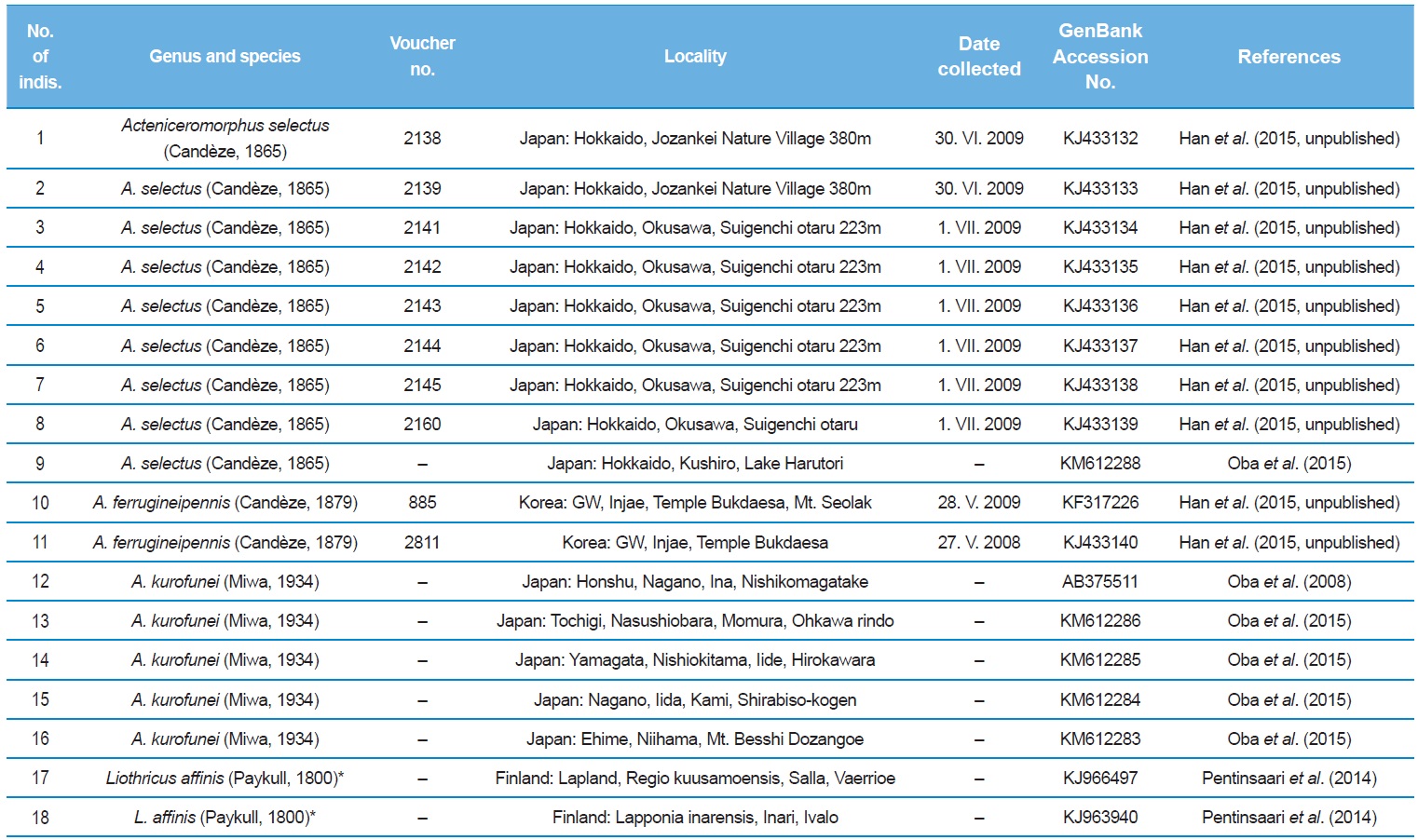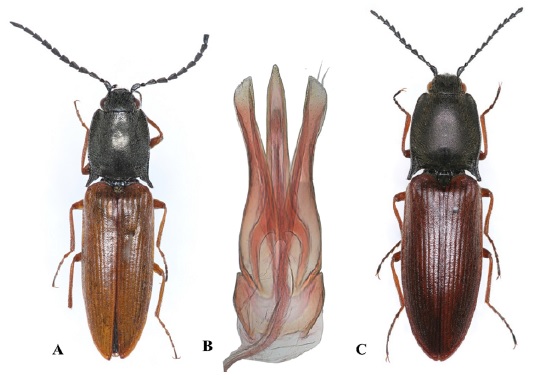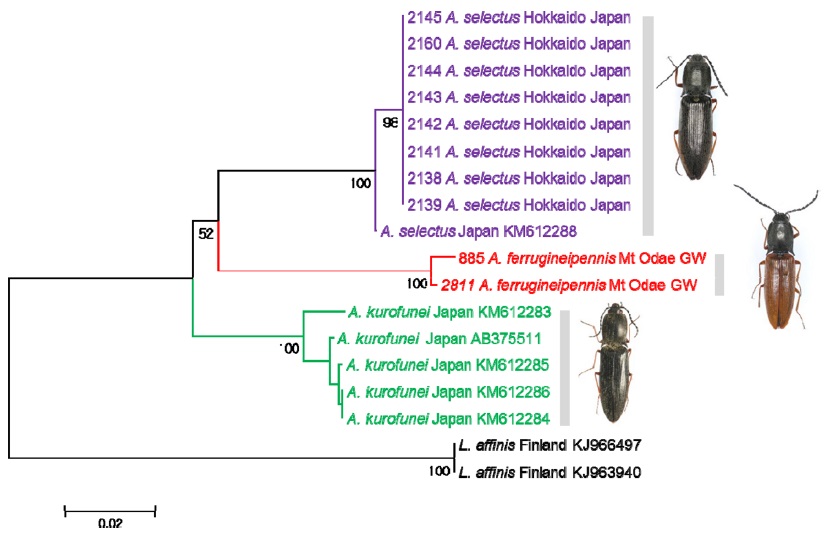Family Elateridae Leach, 1815
Subfamily Denticollinae Stein and J. Weise, 1877 (1856)
Tribe Ctenicerini Fleutiaux, 1936 (1863)
Genus Acteniceromorphus Kishii, 1955 뿔방아벌레속(신칭)
Acteniceromorphus Kishii, 1955: 20, 21. Type-species: Corymbites selectusCandèze, 1865: 53 (Japan); Kishii, 1987: 112; Kishii, 1999: 45.
Liotrichus (Acteniceromorphus): Gurjeva, 1989: 45; Cate, 2007: 177 (Catalogue).
Description. Body medium, weakly metallic luster; frontal carina distinct only on antennal sulci; antenna serrate from the 3rd antennomere; pronotum generally with a median longitudinal canaliculation, or rarely absent, lateral sides narrowly marginate (not flat), hind angles well developed, with a carina, rarely obsolescent, basal incisures of posterior margin distinct; pronotosternal sutures single, sometimes double like only at base; hind angle of hypomeron elongate, posterior margin clearly and broadly emarginated near hind angle; prosternal process longitudinally depressed between procoxae, weakly bent behind procoxae, then nearly straightly extending posteriorly; inner sides of elytral sutures narrowly marginate; parameres of aedeagus simple at apexes (Kishii, 1955, 1987).
Description. Korea, Japan, the Russian Far East, Nepal, Afghanistan, Kyrgyzstan and N. America.
Key to species of the genus Acteniceromorphus in Korea
1. Body stout; 3rd antennomere about 2.0 times longer than 2nd; pronotum a little longer than wide; scutellum flat on disc (Korea and the Russian Far East).....................A. ferrugineipennis
- Body slender, parallel sided; 3rd antennomere about 1.7 times longer than 2nd; pronotum clearly longer than wide; scutellum convex anteriorly (Japan, Korea (?))...............A. chlamydatus
Acteniceromorphus ferrugineipennis (Candèze, 1879)
붉은날개뿔방아벌레(신칭)
Corymbites ferrugineipennis Candèze, 1879: 281 (Amur).
Corymbites (Haplotarsus) ferrugineipennis (Candèze, 1879): Schenkling 1927: 382.
Corymbites patruus Heyden, 1884: 294.
Acteniceromorphus ferrugineipennis (Candèze, 1879): Gurjeva, 1982: 542.
Description. Male (no. 885; Fig. 1A) 12.0 mm long, 2.8 mm wide. Body cylindrical, weakly convex; color black, metallic lustrous, with elytra, apex of mandibles and legs reddish brown, except tarsomeres dusky brown; pubescence short, thin, erect or sub-recumbent, white to pale yellow hairs wholly covered. Head weakly depressed longitudinally between eyes, downwardly declined from eyes to anterior; frontal margin round, depressed at middle, carina complete across front, but obsolete at middle, bifurcate before eyes; punctures small, umbilicate, very dense; intervals reticulate, extremely narrower than diameter of punctures; surface coarse; pubescence short, erect, a little longer than those on pronotum; eyes prominent, with ocelli weakly convex; frontal groove excavated near antennal sulci, then produced forwards, with large umbilicate punctures, narrow medially in anterior view. Antennae rather elongate, from a half of 10th antennomere exceeding beyond hind angles of pronotum, serrated from 4th to 10th; 1st subcylindrical, anterior margin arched; 2nd smallest, obconic, as long as wide; 3rd triangular, 2.0 times as long as wide, 20. times as long as 2nd, 1.5 times as long as 4th; from 4th to 10th each antennomere becoming gradually longer, not narrower to apical; 11th cylindrical, longest. Pronotum quadrate, longer than wide, widest at apex of hind angles, with shallow median longitudinal furrow narrowly; punctures umbilicate, circular, small, very dense wholly, intervals reticulate wholly; surface rugose; anterior margin truncate; anterior angles simple, slightly prominent forwards, antero-lateral margin smoothly curved inwards; lateral sides well marginate narrowly; lateral margins entirely, distinctly carinate, wholly visible in dorsal view, weakly arched, clearly sinuate at base of hind angles; hind angles elongate, diverged latero-posteriorly, slightly bent downwardly in lateral view, apex sharply pointed, with clearly ridged carina; posterior margin with distinct incisures near base of hind angles, with basal notch in front of scutellum. Prosternum convex, narrowest at base, with punctures umbilicate, large, a little smaller than those on pronotum, anterior collar elongate, round, well carinate, slightly bent ventrally, surface smooth, with punctures umbilicate, exceeding to apex of hypomera; posterior process rather cylindrical, narrow, coarse with a little smaller punctures than those of prosternum between procoxal cavities, bent behind, then straightly extending to apex, posterior apex roundly pointed, with an obvious longitudinal furrow extending near apex on each lateral sides in lateral view; procaxal cavities widely open posteriorly; pronotosternal sutures straight, gradually broad to anterior, double at base only, anterior portion simple, closed; hypomeron with umbilicate, smaller, denser than those on pronotum; posterior margin emarginated near procoxal cavities, then nearly straight medially, then clearly and deeply emarginated near hind angles, hind angles slender, truncate at apexes. Scutellum tongue shaped, elongate, narrow 1.3 times as long as wide, widest at anterior margin; anterior margin indistinctly carinate; lateral sides gradually convergent posteriorly; posterior margin round; dorsal surface weakly convex at anterior portion, coarse, puncture small, umbilicate, very dense, with dense hairs. Mesosternum with transverse carinae at each anterior sides, groove large, longitudinal quadrate. Mesocoxal cavities narrowly connected with mesepimeron and broadly touched with mesepisternum, interval between mesocoxae broad. Metasternum convex; median longitudinal suture fine, entire, carinate; hind coxal plates widest at insertion of trochanter, outer-margin slightly convergent to outsides. Legs slender; hind femur sub-equal in length to hind tibia; hind tarsus a little shorter than hind tibiae; hind tarsomeres simple, gradually decreased to 4th; 1st to 5th moderately pilose ventrally; claws simple. Elytra cylindrical, 1.5 times as long as combined length of head and pronotum, 2.25 times as long as wide, flat above, as wide as width of between apices of hind angle of pronotum, widest at two thirds; anterior edge convex; sutural line flat; striae distinctly punctuate as circular, finely furrowed; strial intervals convex, smooth, with minute punctures. Abdomen each lateral margin finely carinate, lacking crenulate; sternite 7, semi-ellpitic, 1.3 times as wide as long. Aedeagus (no. 885; Fig. 1B) slender, elongate, 2.93 times as long as wide; median lobe sub-cylindrical, gradually convergent to apex, then abruptly narrow at apex, apex roundly pointed, a little longer than parameres; parameres slender, simply pointed at apex, apex portions slightly curved inwards, sharply pointed, with two visible setae, lateral outermargins sinuate from posterior two thirds, inner-margins slightly arched; basal strut elongate, reaching median of basal piece; basal piece quadrate, short, widest at anterior third, 1.5 times as long as wide, 0.22 times of length of aedeagus. Female (Fig. 1C). Body size 11.5~16.0 mm long, 2.4~3.5 mm wide, generally larger, stouter than male; antennae clearly shorter, barely reaching before base of hind angles, more weakly serrate, 11th antennomere, shorter, oval shaped, not cylindrical, a little longer than 3rd; lateral margins of pronotum more distinctly arched and stout than male. Reproductive organs: ovipositor short, triangular, cylindrically elongate from middle to apex, with visible setae, apices with short, stout styli; vagina elongate; uterus enlarged at anterior, with weakly developed ballon-like collecterial glands bearing from base, with barely visible sclerotised bands; bursal copulatrix ballon-liked, smaller than uterus, longer than wide, distinctly wrinked at base, a accessory gland short, separately bearing at anterior and below a gland containing another accessory gland and tubular extension, tubular extension elongate, weakly tangled.
Specimens examined. A total of 16 individuals: female, Temple Bukdae-sa in Mt. Odae, Dongsan-ri, Jinbu-myeon, Pyeongchang-gun. 27. V. 2008. S. W. Park leg. (DNA 2811); male, 2 females, ditto, 28. V. 2009. S. W. Park leg. (DNA 885, 2244, 2249); male, 3 females, ditto, 29. V. 1996. S. M. Lee leg.; female, ditto, 30. V. 1995. J. W. Kim leg.; 2 females, Hangyeryong, Injae. 10. VI. 1994. J. Y. Choi leg.; male, Hongcheon. 10. VI. 1995. Y. C. Jeon leg.; female, Mt. Gachilbong, Hongcheon. 6. VI. 1995. G. S. Im leg. female, Bonghwa. 28. V. 1993. D. S. Ku leg.; male, Mt. Sobaek, Yeongju 6. VI. 1981. I. Y. Choi leg. male, Daebul-ri, Seolcheon-myeon, Muju 26. V. 1993. J. I. Kim leg.
Distribution. Korea (new to fauna) and the Russian Far East.
Remarks. This species is recorded in Korea for the first time and usually collected mountainous area in Korea.
Acteniceromorphus chlamydatus (Lewis, 1894)
애붉은큰뿔방아벌레
Corymbite chlamydatus Lewis, 1894: 263 (Yuyama, Japan).
Acteniceromorphus chlamydatus (Lewis): Kishii, 1955: 19, 22.
Korean records
Liotrichus (Acteniceromorphus) chlamydatus (Lewis): Shin and Yoon, 1994: 159 (Checklist).
Acteniceromorphus chlamydatus (Lewis 1894): Kishii, 1999: 46 (Checklist).
Specimens examined. Any Korean specimen of A. chlamydatus is unavailable in this study.
Reference specimens. Acteniceromorphus chlamydatus (Lewis, 1894): 2 males, Wandodani, Sakauchi, Gifu Pref., Japan. 16. V. 1989. I. Kiriyama leg., identified by Dr. H. Ôhira; male, Sagawai, Oyama, Honshu, Japan. 25. IV. 1972. Y. Miyake leg., identified by Dr. H. Ôhira.
Distribution. Japan (endemic) and Korea (?)
Remarks. The species is an endemic species to Japan occurring from Honshu, Shikoku and Kyushu. We could not examine the presence of the species in the Korean fauna and the further study is needed for this species.
Acteniceromorphus selectus (Candèze, 1865)
산꽃큰뿔방아벌레
Corymbites selectus Candèze, 1865: 53 (Japan).
Acteniceromorphus selectus (Candèze): Kishii, 1955: 19, 22.
Korean records
Actenicerus selectus Candèze: Kim and Kim, 1972: 78, 99 (Fauna: 3 ex., Mujugucheondong, JB), misidentification of Hemicrepidius (Hemicrepidius) oblongus (Solsky, 1870).
Acteniceromorphus selectus (Candèze 1865): Kim, 1984: 206 (Fauna: Is. Jeju), misidentification considered by Kishii, 2004b: 2.
Acteniceromorphus selectus (Candèze, 1865): Lee et al., 1985: 407 (fauna: Is. Jeju), misidentification considered by Kishii, 2004b: 2.
Acteniceromorpha[!] selectus (Candèze 1865): Paik et al., 1993: 126 (Fauna: Is. Jeju, “산꽃큰뿔방아벌레” named in Korean), misidentification (?).
Liotrichus (Acteniceromorphus) selectus (Candèze): Shin and Yoon, 1994: 159 (Checklist).
Specimen examined. Any Korean specimen of A. selectus is unavailable in this study.
Reference specimens. Acteniceromorphus selectus (Candèze, 1865): male, female, Jozankei nature village 380 m, Hokkaido, Japan. 30. V. 2009. J. W. Lee leg. (DNA 2138~2139), identified by T. M. Han; male, female, Hokkaido, Japan. 13. V. 1995, A. Kashizaki leg., identified by Dr. H. Ôhira; 5males, female, Suigenchi otaru 223 m, Okusawa, Hokkaido, Japan. 1. VII. 2009. J. W. Lee leg. (DNA 2141~2145, 2160), identified by T. M. Han.
Distribution. Japan (Hokkaido, endemic)
Remarks. A. selectus is an endemic species to Japan occurring only in Hokkaido (Ôhira 1995, Ôhira and Yasuda 1999). Kishii (2004b) pointed out that A. selectus was previously recorded from Is. Jeju by Kim (1984) and Lee et al. (1985), but the true specimen of A. selectus was not examined from the used materials of two previous workers. He considered that the reports of A. selectus from Is. Jeju may be misidentification of an elaterid species. In this study, A. selectus was not found in the elaterid materials stored at FNMJ and Jeju National University in 2009 and 2010, and not collected from Is. Jeju during the past 30 years. Therefore, we proposed that A. selectus may be excluded from the Korean fauna.
Acteniceromorphus fulvipennis (Lewis, 1894)
붉은큰뿔방아벌레
Corymbites fulvipennis Lewis, 1894: 258 (Miyanoshita, Japan).
Acteniceromorphus fulvifennis (Lewis): Kishii, 1955: 19, 22.
Korean records
Actenicerus fulvipennis Lewis: Kim, 1981: 343 (Fauna: Mt. Chukryeong-san, Sudongmyeon, GG), misidentification of Hemicrepidius oblongus.
Liotrichus (Acteniceromorphus) fulvipennis (Lewis): Shin and Yoon, 1994: 159 (Checklist, “붉은큰뿔방아벌레” named in Korean).
Acteniceromorphus fulvipennis (Lewis, 1894): Kishii, 1999: 46 (Checklist).
Specimen examined. Any Korean specimen of A. fulvipennis is unavailable in this study.
Distribution. Japan (endemic).
Remarks. The first Korean record of the species by Kim (1981) was a misidentification of H. oblongus Solsky. Therefore, A. fulvipennis is proposed to be excluded from the Korean fauna. Ôhira (1973) provided taxonomic information in detail.







